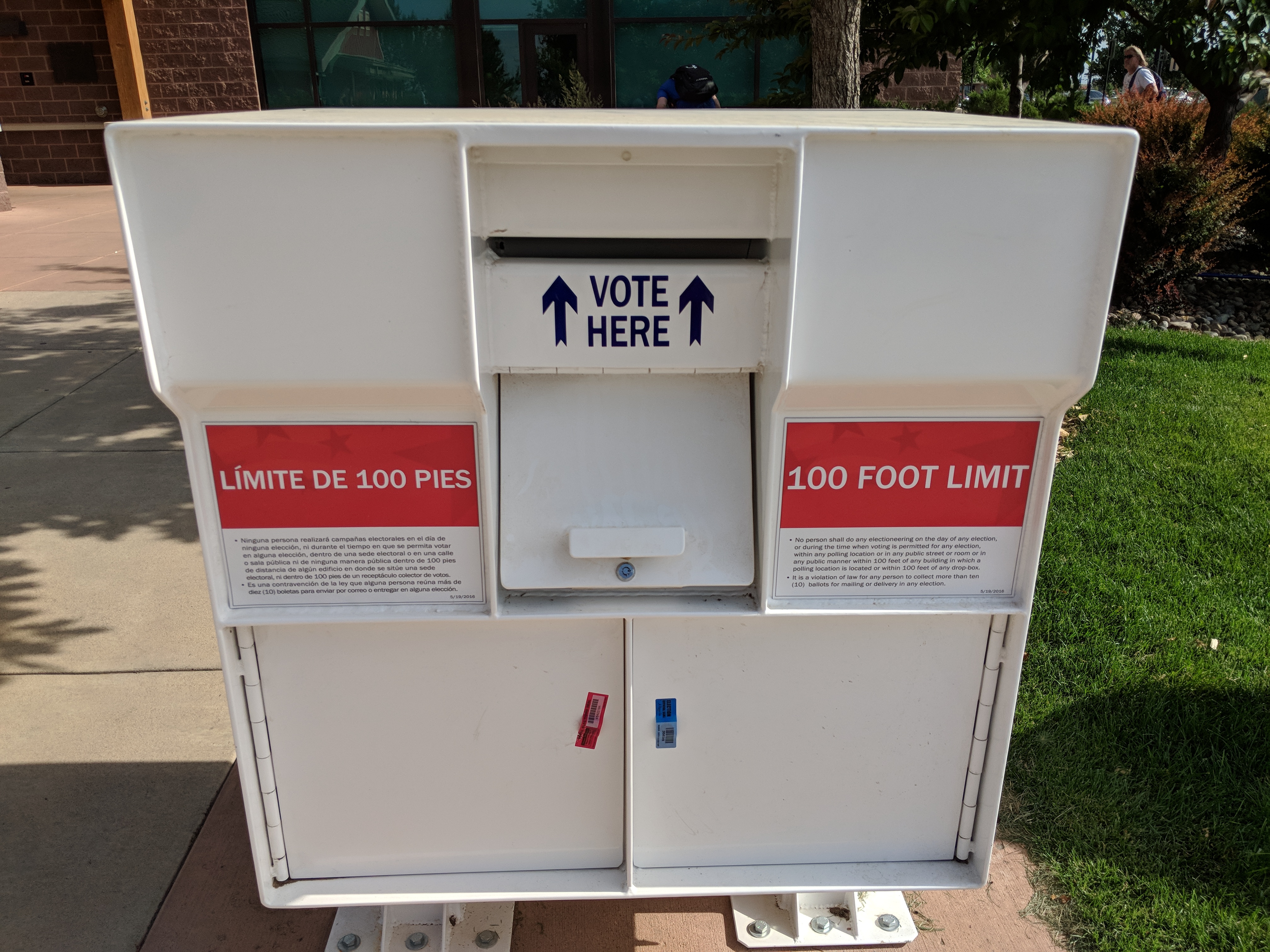Mail Voting Litigation in 2020, Part III: Challenges Seeking to Expand Delivery Options
A raft of litigation has taken place concerning both assistance with mail-in ballots and the means of returning them.

Published by The Lawfare Institute
in Cooperation With

This post is the third of a five-part series on litigation about mail voting during the 2020 general election. This series is part of Lawfare's collaboration with the Stanford-MIT Healthy Elections Project.
This election will see a greater number of mail-in ballots than any general election in U.S. history. What’s more, many voters will be using mail-in ballots for the first time. Millions of voters will thus fill out ballots using an unfamiliar process and then deliver them using infrastructure that, in many cases, was never designed to handle such a massive increase in volume.
Among the many challenges of coping with this reality, states confront two problems associated with the return of mail ballots. First, they must develop a ballot collection system that can handle the rapid growth in mail-in balloting. Some states have chosen to expand the infrastructure for the return of completed absentee ballots, citing the importance of meeting a new surge in demand and protecting public health during the pandemic. Other states, however, have limited ballot drop-off options, arguing that the expansion of vote-by-mail access could lead to election fraud.
Second, states must craft policies that govern how much assistance a voter may receive when filling out and returning a completed absentee ballot. The phrase “absentee voter assistance” often refers to a third party collecting ballots from absentee voters and delivering them to a drop box or elections office. However, it can also refer to ballot delivery, where a third party delivers vote-by-mail ballots or applications to prospective voters. Although some states have made it easier for third parties to assist voters in the vote-by-mail process in 2020, others have fought to preserve bans or limitations on third-party assistance (particularly on ballot collection, which is often pejoratively labeled “ballot harvesting”).
This article—the third in a five-part series from the Stanford-MIT Healthy Elections Project— surveys the major litigation regarding efforts to expand mail-in ballot assistance and mail ballot return delivery issues. It identifies challenges to state laws that prohibit third parties from helping absentee voters complete or deliver their ballots (“absentee voter assistance”). It examines lawsuits around the provision of ballot drop-off locations. And, it discusses ongoing litigation against operational changes at the U.S. Postal Service that may delay ballot delivery in almost every state.
Challenges to laws restricting absentee voter assistance have generally failed. Courts have been reticent to strike down state voting regulations without clear evidence that they place a severe burden on the right to vote. However, litigation over delivery infrastructure (drop boxes and Postal Service changes) has been more successful for vote-by-mail advocates, who have thus far secured several favorable rulings from state and federal courts.
Challenges to Bans on Absentee Voter Assistance
Laws that restrict the ability of third parties to assist absentee voters include laws that restrict the type of person from whom the voter may seek assistance, criminalize the acceptance of compensation for helping return an absentee ballot, limit the number of ballots that a third-party assistant may collect and narrow the circumstances in which an absentee voter may seek assistance. Thus far, plaintiffs have had little success challenging these statutes.
Plaintiffs challenging absentee voter assistance restrictions usually allege two federal constitutional violations. The first constitutional claim is that restrictions on third-party absentee voting assistance are an undue burden on the fundamental right to vote. Courts evaluate laws that burden the franchise under the Anderson-Burdick standard, which balances the burdens that a voting regulation imposes on the electorate against the state’s interests in the regulation. The Anderson-Burdick standard does not fit neatly into traditional tiered review of equal protection claims. Courts generally (but not uniformly) adopt a sliding scale approach: the greater the burden a law places on the franchise, the more robust the state’s justification for the law must be.
Thus far, courts have found that these laws do not place a severe burden on the electorate under Anderson-Burdick. In American Federation of Teachers v. Gardner, a New Hampshire state court refused to enjoin the state’s restrictions on ballot collection and delivery, concluding that it was “not persuaded” that the law “even impose[d] a burden on a voter.” In another case, a federal district court in Tennessee upheld restrictions on ballot collection and delivery, finding that the restrictions imposed a “moderate,” but not “severe,” burden on voters. In Middleton v. Andino, a federal district court in South Carolina similarly declined to find that a “candidate collection ban”— which prohibits political candidates or paid campaign staff from collecting and returning completed absentee ballots—posed a severe burden on the right to vote. The court determined that the ban was “rationally related to the government’s interest in preserving the integrity of elections and preventing voter fraud” and that “[t]he restriction is therefore likely to be upheld as constitutional.”
Courts have taken a skeptical view of challenges to voter assistance bans even without resorting to an Anderson-Burdick analysis. For example, the Pennsylvania Supreme Court recently refused to enjoin state officials from banning third-party delivery of absentee ballots, although it did not explicitly cite the Anderson-Burdick standard.
The second constitutional claim is that state restrictions on absentee voting assistance infringe on civic and political organizations’ First Amendment rights of speech and association. For instance, the plaintiffs in New Georgia Project v. Raffensperger argued that third-party ballot delivery and collection was protected as expressive conduct under the First Amendment. More specifically, the plaintiffs claimed that Georgia’s ban on ballot delivery and collection inhibited civic organizations’ ability to express their views on the importance of voting. The U.S. District Court for the Northern District of Georgia also rejected this argument, noting that both the Fifth and Ninth Circuits have held that ballot and voter application collection is not expressive conduct. Because the court found Georgia’s limitations on ballot collection did not implicate the First Amendment, the law was subject only to rational basis review. Under this lenient standard, the court concluded that Georgia’s stated interest in “combating election fraud and verifying the eligibility of voters” was likely sufficient to uphold the law. Plaintiffs in New Hampshire brought a similar claim in a state court, in American Federation of Teachers. That court, too, cited Fifth and Ninth Circuit rulings in arriving at the conclusion that “the practice of collecting and delivering absentee ballots is not expressive conduct implicating the First Amendment.”
Plaintiffs have also challenged state restrictions on third-party absentee assistance on the grounds that the restrictions violate federal statutes, such as Section 208 of the Voting Rights Act (VRA). Section 208 establishes that “[a]ny voter who requires assistance to vote by reason of blindness, disability, or inability to read or write may be given assistance by a person of the voter’s choice.” In cases in Michigan (Michigan Alliance for Retired Americans v. Benson) and South Carolina (Middleton v. Andino), plaintiffs asserted that absentee assistance restrictions prevented voters with disabilities from receiving assistance from the person of their choice. However, neither court resolved this claim on the merits. In Middleton, the federal district in South Carolina dodged the VRA question, noting that the plaintiffs had failed to raise it in their motion for a preliminary injunction. In Michigan Alliance, a Michigan state court enjoined a state law that allowed only immediate family members (or a person residing in the voter’s household) to return a voter’s absentee ballot; but, the court based its ruling on the Michigan Constitution, not the VRA. And a state appellate court subsequently reversed the lower court ruling, reinstating Michigan’s limitations on third-party absentee ballot delivery.
One of the most high-profile ballot collection cases centers on alleged violations of Section 2 of the Voting Rights Act, which prohibits voting practices and procedures that discriminate on the basis of race, as well as those with a discriminatory impact. In the lawsuit, Arizona Republican Party v. Democratic National Committee, the plaintiffs challenged Arizona state law H.B. 2023, which imposes criminal penalties for assisting with ballot collection. A federal district court upheld the law but, in January, a divided Ninth Circuit, sitting en banc in Democratic National Committee v. Hobbs, reversed, ruling that H.B. 2023 was enacted with discriminatory intent, in violation of Section 2 of the Voting Rights Act. The court determined that the law impacted thousands of Native American, Hispanic and Black voters who had relied on third-party collection. In April, the Arizona Republican Party filed a petition for certiorari to the U.S. Supreme Court. The Supreme Court granted certiorari in early October for a consolidated group of Arizona voting rights cases.
Challenges to Limits on Absentee Ballot Drop-Off Locations
The second category of cases relating to return of mail ballots involves challenges to state limitations on where voters may drop off ballots. The plaintiffs in these cases emphasize how restrictions on drop-off locations can confuse absentee voters, many of whom plan to deposit their ballots at secure drop boxes across their county. Plaintiffs have challenged these types of restrictions in Texas, Ohio and Pennsylvania.
On October 1, Texas Governor Greg Abbott issued a proclamation that restricted each county to a single drop-off location for ballots cast before Election Day. He explained the restrictive move by saying it was needed to prevent voter fraud. The proclamation prompted swift legal challenges, with plaintiffs arguing that the restrictions would burden people with disabilities, the elderly and minority voters, especially in Texas’s largest and most populous counties. They noted the restriction would be especially burdensome in the state’s most populous counties, such as Harris County (which had planned to set up 11 drop-off locations for its over four million residents) and Travis County (which had planned to set up four drop-off locations for its over 1.2 million residents).
In a suit brought in U.S. District Court for the Western District of Texas, the plaintiffs claimed that the governor’s order violated the First and Fourteenth Amendments as an impermissible burden on the right to vote. They also challenged the governor’s order under Section 2 of the Voting Rights Act, claiming it had a disproportionate impact on Latino voters, who have been disproportionately affected by COVID-19. In an order enjoining the state from implementing the restrictions on drop-off locations, U.S. District Judge Robert Pitman said it was “perplexing” that the state could “simultaneously assert the [drop off centers] do not present a risk to election integrity on Election Day but somehow do present such a risk in the weeks leading up to” Election Day. The Fifth Circuit granted a stay of the lower court’s injunction pending appeal.
Parallel proceedings in state court were also unsuccessful. On October 15, just days after the Fifth Circuit’s stay, a Texas state court temporarily enjoined Governor Abbott’s one-per-county rule on drop off centers. Travis County Judge Tim Sulak wrote in an order that the governor’s proclamation “would likely needlessly and unreasonably increase risks of exposure to COVID-19 infections, and needlessly and unreasonably substantially burden potential voters’ constitutionally protected rights to vote ...” After a state appellate court upheld Judge Sulak’s order, the Texas Supreme Court reversed. The court held that the drop box restrictions did not “disenfranchise anyone,” because Texas voters could still take advantage of mail-in ballots or expanded in-person early voting.
In Ohio, Secretary of State Frank LaRose issued Directive 2020-16, which authorized a single secured drop box outside each county board of elections office. Plaintiffs filed lawsuits in both federal and state courts to compel the state to designate additional locations for drop boxes. In mid-September, Judge Richard Frye of the Franklin County Common Pleas Court determined that the Secretary of State’s ban on establishing multiple drop boxes at various locations was “arbitrary and unreasonable.” In response to this state court order, the Ohio Secretary of State permitted each of Ohio's 88 county boards of elections to install more than one drop box, but still required that they be located directly outside of each county’s board of elections offices.
On October 8, Ohio U.S. District Judge Dan Aaron Polster issued an injunction against enforcement of Directive 2020-16. The injunction halted the directive’s prohibition on drop boxes in locations other than directly outside the board of elections office, thus allowing drop boxes to be placed in other locations. The judge’s order also enjoined a ban on the deployment of county board staff to non-elections office ballot boxes. Judge Polster dismissed the state’s contention that multiple drop boxes posed an unacceptable risk of fraud, saying there was “no evidence in the record that suggests that multiple drop boxes cannot be as secure as the single drop box required at each board of elections.” Furthermore, “[n]o evidence was introduced at the hearing to support the conclusory reference to fraud in the Secretary’s brief.” Shortly after Judge Polster’s decision on October 9, a divided Sixth Circuit panel stayed the district court’s injunction pending interlocutory appeal.
In Pennsylvania, the Trump campaign also sought an injunction in federal district court against the state’s use of drop boxes for absentee ballots. The Pennsylvania Supreme Court has already held that the Pennsylvania Election Code allows counties to establish drop boxes beyond those at their main county office locations. The federal district court addressed the merits of the Trump campaign’s federal constitutional claims against Pennsylvania’s use of drop boxes. The Trump campaign argued that Pennsylvania’s use of drop boxes violates equal protection because the state permits different counties to use drop boxes to varying extents and with varying degrees of security. In his October 10 order granting summary judgment in favor of the state, Judge Ranjan held that there was no unequal treatment because “the result of ... uneven implementation [of drop boxes] will not be votes in certain counties being valued less than others ... [or] ... voters who vote in person [having] their votes valued less … Instead, if Plaintiffs are right, any unlawful votes will dilute all other lawful votes in the same way.” The Trump campaign plans to appeal the Pennsylvania district court’s ruling to the Third Circuit.
Finally, plaintiffs have challenged restrictions on voting options that occupy a middle ground between absentee voting and traditional in-person voting. Most notably, plaintiffs in Alabama recently filed a lawsuit in federal court, seeking to enjoin Alabama’s ban on curbside voting. Curbside voting allows disabled or elderly voters to cast a ballot from their vehicle outside a polling place and therefore minimizes transmission risk for vulnerable voters. The district court agreed with plaintiffs, concluding that the ban violated the First and Fourteenth Amendments, as well as the Americans with Disabilities Act. The district court issued a temporary injunction against the ban, and the Eleventh Circuit affirmed. But on October 21, in a 5 to 3 vote, the U.S. Supreme Court reversed, with Justices Sonia Sotomayor, Elena Kagan and Stephen Breyer dissenting.
Challenges to USPS Operational Changes
The final group of lawsuits target the entity that will deliver millions of ballots during the election season: the U.S. Postal Service. Recent operational changes at the Postal Service caused nationwide slowdowns in mail delivery. In response, 24 state attorneys general filed federal lawsuits against the Trump administration and U.S. Postmaster General Louis DeJoy in Washington, Pennsylvania and the District of Columbia. Civil rights organizations and individual petitioners have filed similar lawsuits in the District of Columbia (three related filings), Pennsylvania and Illinois. Several members of the New York legislature have also joined individual voters to file a complaint in U.S. District Court for the Southern District of New York.
Collectively, these lawsuits seek to enjoin the Postal Service from eliminating overtime hours for workers processing the mail, decommissioning mail sorting machines that help speed the processing of mail, removing post office mail collection boxes and declassifying election mail as first-class mail. The lawsuits allege that the Postal Service’s recent actions violate various federal statutory and constitutional provisions.
The central statutory claim involves the Postal Reorganization Act (“PRA”), which created the Postal Service’s Board of Governors and the Postal Regulatory Commission. Under 39 U.S.C. § 3661(b), the Postal Service must request an advisory opinion from the Postal Regulatory Commission before making a “change in the nature of postal services which will generally affect service on a nationwide or substantially nationwide basis.” The complaints allege that the Postal Service implemented its “transformative” changes in mail service on a nationwide basis without obtaining an advisory opinion from the Postal Regulatory Commission. The lawsuits seek to enjoin the Postal Service from implementing any changes that have a nationwide effect on delivery service without first satisfying the necessary statutory and regulatory procedures.
The lawsuits also raise constitutional claims. The individual and civil rights plaintiffs allege that the Postal Service’s actions—which could potentially delay the delivery of millions of mail-in ballots—are an unconstitutional infringement on the right to vote. Meanwhile, the state attorneys general allege that the Postal Service’s actions “on the eve of the 2020 election—well after the [s]tates have established systems for voting using the Postal Service—impermissibly interfere with the states’ constitutional rights to set the “Time, Places, and Manner of holding Elections for Senators and Representatives” under Art. I, § 4 of the U.S. Constitution and to appoint presidential electors “in such manner” as their legislatures direct under Art. II, § 1.
Thus far, four different federal district courts have sided with the individual and state plaintiffs. On September 17, Judge Stanley Bastian of the Eastern District of Washington granted a nationwide injunction against the Postal Service’s operational changes. Four days later, Judge Victor Marrero of the Southern District of New York also enjoined the Postal Service from instituting its operational changes. Among other things, Judge Marrero’s detailed order requires the Postal Service to treat all election mail as First-Class or Priority Express mail; mandates the approval of requested overtime between October 26 and November 6 and requires the Postal Service to draft a “guidance memorandum” for managerial staff on the proper handling of election mail. Six days after Judge Marrero’s ruling, Judge Emmet Sullivan of the U.S. District Court for the District of Columbia issued an injunction. Finally, on September 28, U.S. District Court for the Eastern District of Pennsylvania also enjoined the Postal Service’s operational changes in a ruling that explicitly adopted Judge Marrero’s order. The Pennsylvania order also forbade future implementation of the proposed operational changes until the Postal Service receives an advisory opinion from the Postal Regulatory Commission.
Conclusion
The widespread adoption of vote-by-mail has spurred litigation against efforts to restrict the use of absentee ballots. Although challenges to restrictions on ballot collection and delivery have gained little traction thus far, proponents of vote-by-mail have scored key victories on the issues of ballot drop boxes and the U.S. Postal Service. However, other battles—particularly the Texas litigation on the one-per-county drop box rule—remain unresolved.
Ultimately, vote-by-mail remains one of the most effective options for running a nationwide election during a crippling pandemic, and states will need to balance the need for election security against the right of individual voters to cast votes without placing their health at risk.







